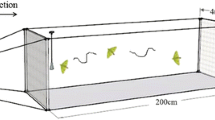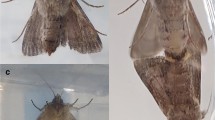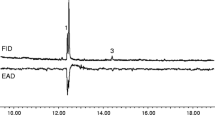Abstract
The behavioral responses of Lobesia botrana males to calling females, pheromone gland extracts, and synthetic sex pheromones were recorded in a wind tunnel. Gland extracts and synthetic pheromones were released from a pheromone evaporator. The numbers of males reaching the source and their flight tracks in response to calling females and pheromone gland extracts were compared to those of synthetic blends. Upwind flights to natural sex pheromone were straighter and faster than to a three-component blend of (E)-7,(Z)-9-dodecadienyl acetate (E7,Z9–12:Ac), (E)-7,(Z)-9-dodecadien-1-ol (E7,Z9–12:OH), and (Z)-9-docecenyl acetate (Z9–12:Ac) (100:20:5). The optimum ratio of E7,Z9–12:OH and Z9–12:Ac to E7,Z9–12:Ac was found to be 5% and 1%, respectively. An additional seven compounds identified in the sex pheromone gland were investigated for their biological activity. Two unsaturated acetates, i.e., (E)-9-dodecenyl acetate (E9–12:Ac) and Δ11-dodecenyl acetate (Δ11–12:Ac), increased the number of males reaching the source as well as straightness, linear velocity, and decreased the track angle of upwind flight. Optimum response was obtained by releasing 10 pg/min E7,Z9–12:Ac in a mixture with 0.5 pg/min E7,Z9–12:OH, 0.1 pg/min Z9–12:Ac, 0.1 pg/min E9– 12:Ac and 1 pg/min Δ11-12–Ac. The saturated acetates previously identified in the female glands were biologically inactive.
Access this article
We’re sorry, something doesn't seem to be working properly.
Please try refreshing the page. If that doesn't work, please contact support so we can address the problem.
Similar content being viewed by others
REFERENCES
Arn, H., Rauscher, S., Guerin, P., and Buser, H.-R. 1988. Sex pheromone blends of three tortricid pests in European vineyards. Agric., Ecosyst. Environ. 21:111-117.
Arn, H., TÓth, M., and Priesner, E. 1992. List of Sex Pheromones of Lepidoptera and Related Attractants, 2nd ed. International Organization for Biological Control, Montfavet.
Arn, H., TÓth, M., and Priesner, E. 1998. List of Sex Pheromones of Lepidoptera and Related Attractants. Internet Edition. http://www-pherolist.slu.se.
Baker, T. C., Meyer, W., and Roelofs, W. L. 1981. Sex pheromone dosage and blend specificity of response by oriental fruit moth females. Entomol. Exp. Appl. 30(3):269-279.
Baker, T. C., Francke, W., Miller, J. G., LÖfstedt, C., Hansson, B., Du, J. W., Phelan, P. L., Vetter, R. S., Youngman, R., and Todd, J. L. 1991. Identification and biossay of sex pheromone components of carob moth, Ectomyelois ceratoniae (Zeller). J. Chem. Ecol. 17:1973-1987.
Buser, H.-R., Rauscher, S., and Arn, H. 1974. Sex pheromone of Lobesia botrana: (E,Z)-7,9-Dodecadienyl acetate in the female grape vine moth. Z. Naturforsch. 29c:781-783.
El-Sayed, A. 1996. Analysis of behaviour and chemical stimuli in sex attraction in Lobesia botrana (Lepidoptera: Tortricide). PhD thesis. Zürich University, Zürich.
Guerin, P. M., Arn, H., Buser, H. R., and Charmillot, P. J. 1986. Sex pheromones of Adoxophyes orana: Additional components and variability in ratio of (Z)-9-and (Z)-11-tetradecenyl acetate. J. Chem. Ecol. 12:763-771.
Linn, C. E., Jr., and Roelofs, W. L. 1983. Effect of varying proportions of the alcohol component on sex pheromone blend discrimination in male oriental fruit moths Grapholitha molesta. Physiol. Entomol. 8:291-306.
Linn, C. E., Jr., and Roelofs, W. L. 1989. Response specificity of male moths to multicomponent pheromones. Chem. Senses 14:421-437.
Linn, C. E., Campbell, M. G., and Roelofs, W. L. 1988. Temperature modulation of behavioural thresholds controlling male moth sex pheromone response specificity. Physiol. Entomol. 13:59-68.
Liu, Y. B., and Haynes, K. F. 1993. Impact of (Z)-7-dodecenol and turbulence on pheromone-mediated flight manoeuvres of male Trichoplusia ni. Physiol. Entomol. 18(4):363-371.
Palaniswamy, P., Underhill, E. W., Steck, W. F., and Chisholm, M. D. 1983. Responses of male redbacked cutworm, Euxoa ochrogaster (Lepidoptera: Noctuidae), to sex pheromone components in a flight tunnel. Environ. Entomol. 12:748-752.
Quartey, G. K., and Coaker, T. H. 1993. Role of sex pheromone components in the orientation behaviour of Ephestia cautella. Entomol. Exp. Appl. 66(3):237-245.
Rauscher, S., Arn, H., and Guerin, P. 1984. Effects of dodecyl acetate and (Z)-10-tridecenyl acetate on attraction of Eupoecilia ambiguella males to the main sex pheromone component, (Z)-9-dodecenyl acetate. J. Chem. Ecol. 10:253-264.
Roelofs, W. L., and Wolf, W. 1988. Pheromone biosynthesis in the Lepidoptera. J. Chem. Ecol. 14:2019-2031.
Roelofs, W. L., Kochansky, J., CardÉ, R. T., Arn, H., and Rauscher, S. 1973. Sex attractant of the grape vine moth, Lobesia botrana. Mitt. Schweiz. Entomol. Ges. 46:71-73.
Sanders, C. J. 1984. Sex pheromone of the spruce budworm (Lepidoptera: Tortricidae); Evidence for a missing component. Can. Entomol. 116:93-100.
StatView. 1995. StatView for Macintosh, version 4.5. Abacus concepts Berkeley, California.
Vetter, R. S., and Baker, T. C. 1983. Behavioral responses of male Heliothis virescens in a sustained flight tunnel to combinations of seven compounds identified from female sex pheromone glands. J. Chem. Ecol. 9:747-759.
Willis, M. A., and Baker, T. C. 1987. Comparison of manoeuvres used by walking versus flying Grapholita molesta males during pheromone-mediated upwind movement. J. Insect Physiol. 33:875-883.
Willis, M. A., and Baker, T. C. 1988. Effects of varying sex pheromone component ratios on the zigzagging flight movements of the oriental fruit moth Grapholita molesta. J. Insect Behav. 1(4):357-372.
Witzgall, P. 1990. Attraction of Cacoecimorpha pronubana male moths to synthetic sex pheromone blends in the wind tunnel. J. Chem. Ecol. 16:1507-1516.
Witzgall, P. 1996. Modulation of pheromone-mediated flight in male moths, pp. 265-274, in R. T. Cardé and A. K. Minks (eds.). Insect Pheromone Research. New Directions. Chapman and Hall, New York.
Witzgall, P., and Arn, H. 1990. Direct measurement of the flight behaviour of male moths to calling females and synthetic sex pheromones. Z. Naturforsch. 45c:1067-1069.
Witzgall, P., and Arn, H. 1991. Recording flight tracks of Lobesia botrana in the wind tunnel, pp. 187-193, in I. Hrdy (ed.). Insect Chemical Ecology. Academia Praha and SPB Academic Publishers, The Hague.
Witzgall, P., and Bengtsson, M., Buser, H. R., Chambon, P. J., Priesner, E., Wildbolz, T., and Arn, H. 1991. Sex pheromones of Spilonota ocellana and Spilonota laricana. Entomol. Exp. Appl. 60:219-223.
Author information
Authors and Affiliations
Rights and permissions
About this article
Cite this article
El-Sayed, A., Gödde, J., Witzgall, P. et al. Characterization of Pheromone Blend for Grapevine Moth, Lobesia botrana by Using Flight Track Recording. J Chem Ecol 25, 389–400 (1999). https://doi.org/10.1023/A:1020811200054
Issue Date:
DOI: https://doi.org/10.1023/A:1020811200054




